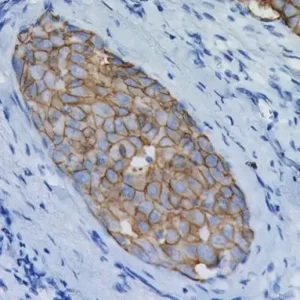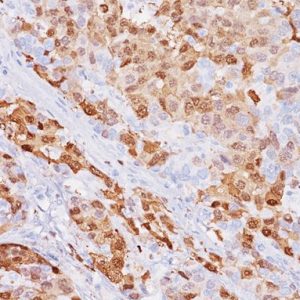Description
The ROS1 gene encodes ROS proto-oncogene 1, a receptor tyrosine kinase. The ROS1 protein is an enzyme with a mass of 263.9 kDa. ROS1 gene rearrangements have been implicated in multiple cancer indications including non-small cell lung cancer (NSCLC), gastric cancer, glioblastoma multiforme, ovarian cancer, and colorectal cancer (1). ROS1 protein fusion expression leads to oncogenic transformation, most likely through constitutive activation of the tyrosine kinase domain (2). ROS1 gene rearrangements occur in 1-2% of NSCLC, and clinical trial data indicates that tumors positive for ROS1 protein fusions are sensitive to kinase inhibitors such as crizotinib, and entrectinib (3,4). For detection of positive ROS1 fusions, IHC testing has been shown 100% sensitivity and 92-94% specificity in recent studies, proving its efficacy as a screening tool for ROS1-targeted therapies (5,6).
SPECIFICATIONS
Specifications
| INTENDED USE | IVD |
|---|---|
| CLONE | EPMGHR2 |
| LOCALIZATION | Cytoplasmic |
| ANTIGEN | Synthetic peptide within Human ROS1 |
| POSITIVE CONTROL | Lung adenocarcinoma |
| SOURCE | Rabbit Monoclonal |
| ISOTYPE | IgG |
| SPECIES REACTIVITY | Human |
DATASHEET AND SDS
REFERENCES
1. Gainor JF, Shaw, AT. Novel Targets in Non-Small Cell Lung Cancer: ROS1 and RET Fusions. Oncologist. 2013;18(7):865-75. 2. Davies KD, Doebele RC. Molecular pathways: ROS1 fusion proteins in cancer. Clin Cancer Res. 2013 Aug 1;19(15):4040-5. 3. Bubendorf L, et al. Testing for ROS1 in non-small cell lung cancer: a review with recommendations. Virchows Arch. 2016 Nov;469(5):489- 503. 4. Facchinetti F, Friboulet L. Profile of entrectinib and its potential in the treatment of ROS1-positive NSCLC: evidence to date. Lung Cancer (Auckl). 2019 Sep 9;10:87-94. 5. Sholl LM, et al. ROS1 immunohistochemistry for detection of ROS1- rearranged lung adenocarcinomas. Am J Surg Pathol. 2013 Sep;37(9):1441-9. 6. Shan L, et al. Detection of ROS1 gene rearrangement in lung adenocarcinoma: comparison of IHC, FISH and real-time RT-PCR. PLoS One. 2015 Mar 5;10(3):e0120422. 7. Center for Disease Control Manual. Guide: Safety Management, NO. CDC-22, Atlanta, GA. April 30, 1976 “Decontamination of Laboratory Sink Drains to Remove Azide Salts.” 8. Clinical and Laboratory Standards Institute (CLSI). Protection of Laboratory Workers from Occupationally Acquired Infections; Approved Guideline-Fourth Edition CLSI document M29-A4 Wayne, PA 2014.







Reviews
There are no reviews yet.